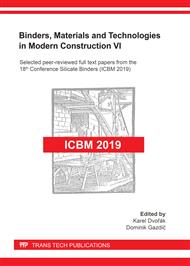[1]
V.Q. Le, H.T. Nguyen, Evaluation on Roles of Activated Silicon and Aluminum Oxides for Formation of Geopolymer from Red Mud and Silica Fume, Key Eng. Mat., 777 (2018) 513-517.
DOI: 10.4028/www.scientific.net/kem.777.513
Google Scholar
[2]
Q.M. Do, T.H. Bui, H.T. Nguyen, Effects of Seawater Content in Alkaline Activators to Engineering Properties of Fly Ash-Based Geopolymer Concrete, Sol. Sta. Phe. 296 (2019) 105-111.
DOI: 10.4028/www.scientific.net/ssp.296.105
Google Scholar
[3]
H.T. Nguyen, V.Q. Le, T.H. Bui, Leaching Behavior and Immobilization of Heavy Metals in Geopolymer Synthesized from Red Mud and Fly Ash, Key Eng. Mat., 777 (2018) 518-522.
DOI: 10.4028/www.scientific.net/kem.777.518
Google Scholar
[4]
V.Q. Le, M.Q. Do, H.T. Nguyen, Effect of Alkaline Activators to Engineering Properties of Geopolymer-Based Materials Synthesized from Red Mud, Key Eng. Mat. 777 (2018) 508-512.
DOI: 10.4028/www.scientific.net/kem.777.508
Google Scholar
[5]
H.T. Nguyen, H.L.N. Nguyen, Novel materials synthesized from red mud, bagasse, and bentonite for gas treatment by CO2 absorption, MATEC Web of conf. 207, 03005 (2018).
DOI: 10.1051/matecconf/201820703005
Google Scholar
[6]
P.T. Kien, T.T.T. Ly, N.H. Thang, M.M.A.B. ABDULLAH, A Novel Study on Using Vietnam Rice Hush Ash and Cullet as Environmental Materials, MATEC Web of Conferences 97, 1-6.
DOI: 10.1051/matecconf/20179701118
Google Scholar
[7]
H.T. Nguyen, V.T.H.Q. Pham, Leachability of heavy metals in geopolymer-based materials synthesized from red mud and rice husk ash, AIP Conference Proceedings 1954 (1) (2018) 040014.
DOI: 10.1063/1.5033414
Google Scholar
[8]
H.T. Nguyen, V.T.H.Q. Pham, T.N. Le, T.P. Dang, N.K.T. Nguyen, Utilization of red mud and bagasse for production of gas absorption materials, AIP Conf. Proc. 1954 (1) (2018) 040010.
Google Scholar
[9]
H.T. Nguyen, T.N. Le, V.T.H.Q. Pham, Development of heat resistant geopolymer-based materials from red mud and rice husk ash, AIP Conf. Proc. 1954 (1) (2018) 040005.
Google Scholar
[10]
H.T. Nguyen, N.H. Nguyen, T.K. Pham, Engineering properties of lightweight geopolymer synthesized from coal bottom ash and rice husk ash, AIP Conference Proceedings 1954 (1), 040009.
DOI: 10.1063/1.5033409
Google Scholar
[11]
H.T. Nguyen, Synthesis and Characteristics of Inorganic Polymer Materials Geopolymerized from Ash of Brickyard, Materials Science Forum 961 (2019) 45-50.
DOI: 10.4028/www.scientific.net/msf.961.45
Google Scholar
[12]
H.T. Nguyen, Evaluation on Formation of Aluminosilicate Network in Ternary-Blended Geopolymer Using Infrared Spectroscopy, Solid State Phenomena 296 (2019) 99-104.
DOI: 10.4028/www.scientific.net/ssp.296.99
Google Scholar
[13]
D. Jozíc, J. Zelíc, I. Janjatovíc, influence of the coarse fly ash on the mechanical properties of the cement mortars, Ceramics – Silikáty, 54 (2) (2010) 144-151.
Google Scholar
[14]
H.T. Nguyen and T.P. Dang, Characterization of Hydroxyapatite Synthesized from Calcium Hydroxide and Phosphoric Acid as Adsorbents of Lead in Wastewater, Materials Science Forum 991 (2020) 159-165.
DOI: 10.4028/www.scientific.net/msf.991.159
Google Scholar
[15]
Q.M. Do, T.T.L. Nguyen, V.T.H.Q. Pham, H.T Nguyen, The Novel Crystalline Glaze for Decoration of Ceramic Pottery, Materials Science Forum 987 (2020) 165-170.
DOI: 10.4028/www.scientific.net/msf.987.165
Google Scholar
[16]
T.H.T Le, H.T. Nguyen, V.K. Nguyen, T.L. Nguyen, T.T. Nguyen, Effect of HCl-Alcoholic Treatment on the Modification of Jackfruit (Artocarpus heterophyllus Lam) Seed Starch, Materials Science Forum 991 (2020) 150-156.
DOI: 10.4028/www.scientific.net/msf.991.150
Google Scholar


